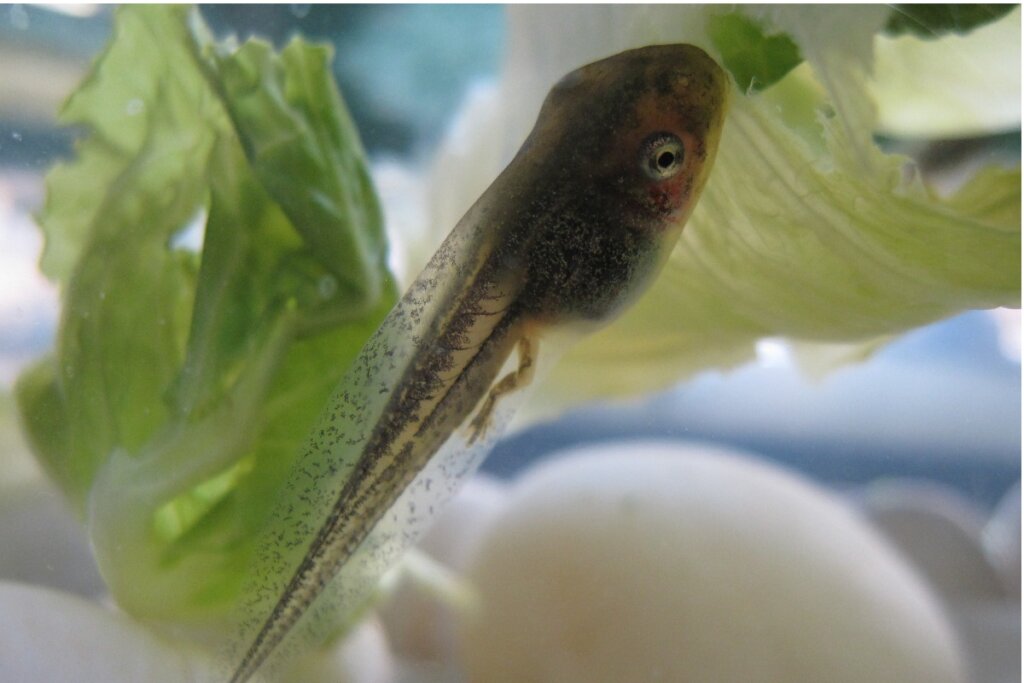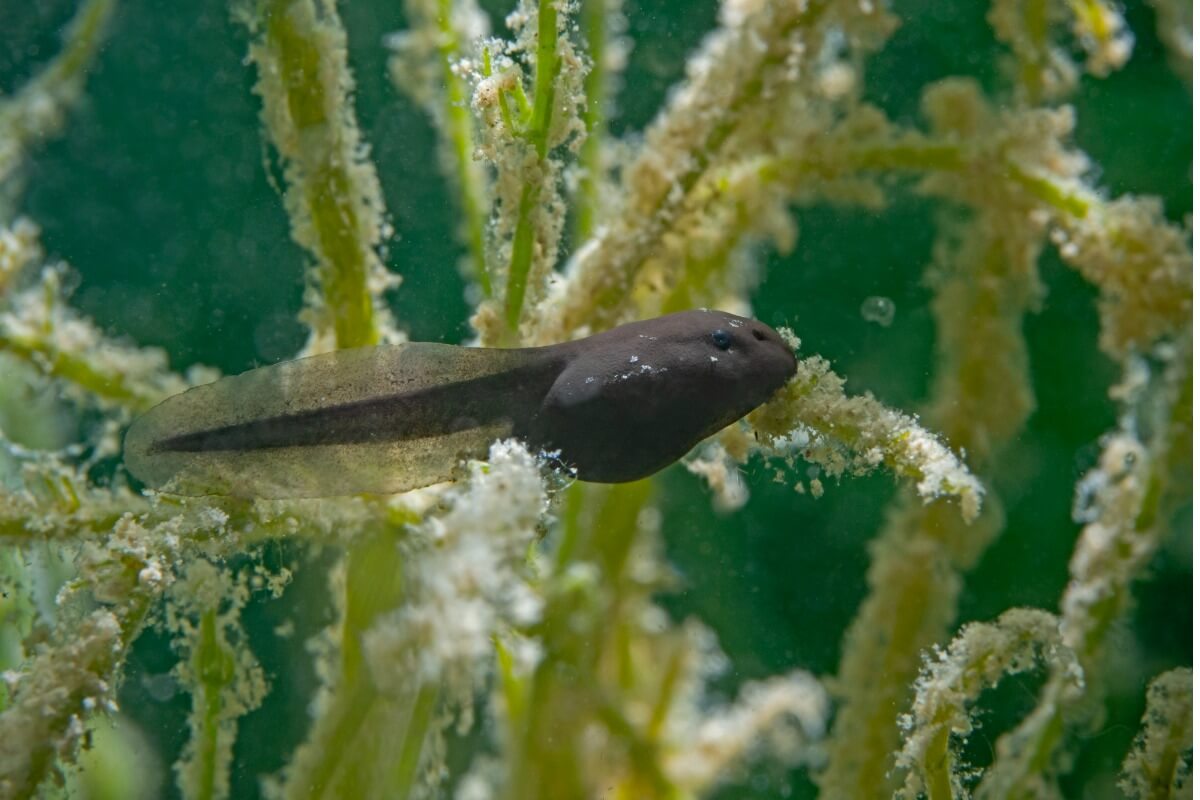What Do Tadpoles Eat?

Anuran amphibians go through a complex life cycle that makes them completely transform in order to reach their adult stage. In other words, they undergo a metamorphosis process, in which they change their larval appearance and transform into the typical frogs or toads. Even so, before that, they live as tadpoles and live, eat and behave differently from adult anurans.
Despite their importance, little attention is paid to frog and toad larvae, as they barely last a few weeks in this stage. Due to its transience, much of its diet, behavior, and characteristics are overlooked. Therefore, in this article, we’re going to show you more about their biological makeup. Read on and find out what they are, what they eat, and some more facts about tadpoles.
What are tadpoles?
Tadpoles represent a part of the life cycle of anuran amphibians. The appearance of the larvae is very similar to that of a small fish, and their long tail and external gills give them a distinctive appearance. This stage is unique in tailless amphibians (anurans), as their sister group (caudates) have larvae that are more similar to adults.
In other words, these tadpoles are the ones that hatch after the incubation of the egg and remain in this state for between 1 and 3 months on average. During this time, they go through metamorphosis, which is a complete transformation from their “fish” appearance to the form of a frog or toad. This process is progressive, so each structure appears little by little.
It could be said that this cycle summarizes years of evolution in a few months, since this change resembles the passage of living beings from water to land. If you want to see it in a simpler way, the metamorphosis process could be compared to what the fish had to do to give rise to the rest of the vertebrates. This is one of the most fascinating qualities of amphibians.
The latter is just an analogy, as metamorphosis and evolution are very different processes. The latter is expressed after thousands of years of speciation.

What do tadpoles eat?
The main objective of the tadpoles is to grow as fast as possible to reach the requirements of their metamorphosis. For this reason, their diet should contain foods that are abundant in water. This explains why they’re herbivorous organisms, as plants are usually one of the easiest resources to find. In addition to this, they can also feed on sediment or by filtering the water when swimming.
Although it has been said that tadpoles prefer to eat plants, the way they do so depends a lot on the structure of their mouth. In fact, they can have a type of very simple teeth called keratodonts, which serve to gnaw on stones or grind their food. Likewise, depending on the hardness of these “teeth”, the larvae are capable of eating animal remains or other tadpoles.
The latter may intrigue you, as we mentioned above that they were herbivores. However, in rare cases, tadpoles are more opportunistic and eat whatever is available in their environment. In the end, what they most need to do is to grow, as in the water they can be victims of many predators.
The sooner it becomes a frog or toad, the sooner the tadpole will be out of its most fragile stage.
What do I do if I have a captive tadpole?
Since frogs and some toads have become popular pets, chances are that, at some point, you’ll think about breeding them. Therefore, you may wonder what tadpoles eat in captivity or what you need to do to look after them.
First of all, it’s worth remembering that the laws of some countries don’t allow the collection of eggs, tadpoles or specimens of certain frogs and toads. This means that you must be careful with the purchase, sale, and capture of protected species that aren’t allowed in your area. In addition, keep in mind that they’re living beings and not playthings, so make sure they have what it takes to survive.
Tadpole food in captivity
Once the tadpoles are installed and attached to their artificial habitat, you must feed them with some type of vegetation. They have a special predilection for the genus Elodea, although if you manage to get algae of another type to complement it, it would be much better. Fresh lettuce and spinach work quite well, just remember to wash them well to avoid illness.
It’s also possible to use commercial pellets for fish whose diet is mostly algae such as spirulina. Avoid them if the characteristics of the processed food aren’t met, as many variants use material of animal origin, which can harm them. All of the above is closely linked to the herbivorous habits of tadpoles, as you’ll remember this is their main way of feeding.
How many times a day do tadpoles eat?
As for quantity, there are no rigid rules. This is because it’ll depend a lot on the availability of the nutrients that each species has in its natural habitat. However, the general recommendation is that 2 to 3 meals a day are provided in small quantities. In this way, you’ll be able to observe how much uneaten food remains and you’ll be able to adjust the dose to reduce waste.
Although their food is usually crushed, this isn’t necessary, but it does allow you to have better control over the quantities. As their limbs grow and appear, the tadpoles will begin to consume meat, so you can continue with the pellets or start an insectivorous diet. At this stage, it’s better to use larvae, worms, or some microarthropods that complement their nutrition.
In their adult phase, all frogs and toads are insectivores.
If you see a group of tadpoles in a stream you may be tempted to take them home. However, looking after them isn’t a game nor should it be taken lightly, as we’re talking about a living being, not a toy. All species contain a particular beauty within themselves that can be appreciated from within their natural environments.
All cited sources were thoroughly reviewed by our team to ensure their quality, reliability, currency, and validity. The bibliography of this article was considered reliable and of academic or scientific accuracy.
- Teplitsky, C., Plénet, S., Léna, J. P., Mermet, N., Malet, E., & Joly, P. (2005). Escape behaviour and ultimate causes of specific induced defences in an anuran tadpole. Journal of evolutionary biology, 18(1), 180-190.
- Eterovick, P. C., & Barros, I. S. (2003). Niche occupancy in south-eastern Brazilian tadpole communities in montane-meadow streams. Journal of tropical ecology, 19(4), 439-448.
- Caut, S., Angulo, E., Díaz-Paniagua, C., & Gomez-Mestre, I. (2013). Plastic changes in tadpole trophic ecology revealed by stable isotope analysis. Oecologia, 173(1), 95-105.
- Mijares-Urrutia, A. (1998). Los renacuajos de los anuros (Amphibia) altoandinos de Venezuela: morfología externa y claves. Revista de Biología Tropical, 46(1), 119-143.
- Altig, R. (2006). Tadpoles evolved and frogs are the default. Herpetologica, 62(1), 1-10.
- Crump, M. L. (1986). Cannibalism by younger tadpoles: another hazard of metamorphosis. Copeia, 1986(4), 1007-1009.
- Kupferberg, S. J. (1997). The role of larval diet in anuran metamorphosis. American Zoologist, 37(2), 146-159.
- O’Rourke, D. P., & Rosenbaum, M. D. (2015). Biology and diseases of amphibians. In Laboratory animal medicine (pp. 931-965). Academic Press.
